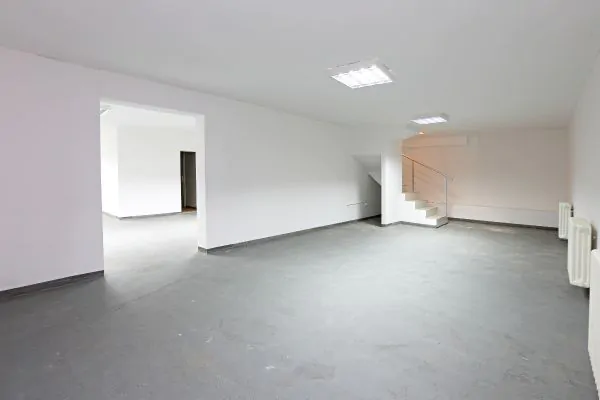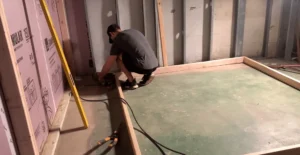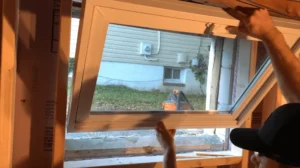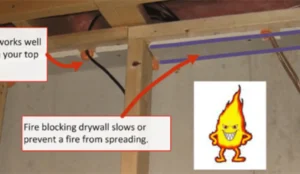Thinking about adding a basement to your house? This guide will break down everything you need to know. Adding a basement can open up new space for living and storage, potentially boosting your home’s value by as much as 20%.
This process involves planning, digging out the earth, making concrete walls stand tall, and ensuring everything stays dry with waterproofing techniques. The price tag for this big change ranges from $50,000 to $150,000 on average.
But before you start dreaming of that extra square footage, remember you’ll need the green light from local authorities through necessary permits and approvals.
Adding a basement is no small feat. You might face interruptions in your daily life due to extensive excavation work required or adjustments needed if there’s a lot of water lapping at your property lines.
If diving deep into construction isn’t for you, consider simpler options like creating crawl spaces under your house or adding separate sheds for more storage without breaking the bank.
Every step of this project demands careful thought and professional advice – from sketching out plans to dealing with any water trying to sneak its way in once all is said and done.
Ready to find out more? Let’s dig in!
Key Takeaways
- Adding a basement increases living and storage space, potentially boosting your home’s resale value. Homes with basements often sell for more because buyers value the extra space.
- The cost of adding a basement can range from $50,000 to $150,000 depending on factors like plumbing and electrical work. Specific projects like remodeling an existing basement might cost between $30,000 to $70,000 or more.
- Before starting construction, you must get the necessary permits and approvals from local authorities to ensure your project complies with building codes and regulations.
- The process of adding a basement includes planning and preparation, excavation of the site, pouring concrete walls for foundation support, and waterproofing to prevent water infiltration.
- Alternatives like building a crawl space or converting attic space provide additional options for increasing storage or living area without the extensive work required for adding a full basement.
Benefits of Adding a Basement to Your House
Adding a basement to your house offers increased living space and more storage options. It also has the potential to boost the resale value of your property.
Increased living space
Expanding your home by adding a basement creates valuable extra square footage. This new area can serve multiple purposes, from a cozy family room to an additional sleeping chamber.
It transforms unused ground beneath your house into a practical, livable space.
With this expansion, you can organize your belongings more efficiently by moving items not regularly used into the newfound storage areas, freeing up more room in the rest of your home.
Whether it’s for entertainment, work, or relaxation, this addition brings endless possibilities to enhance your daily living experience. By investing in a basement remodel, families gain the flexibility to design spaces that truly suit their needs and tastes without moving or sacrificing yard space.
Additional storage space
Creating extra storage space with a new basement tackles the issue of overflowing closets and cluttered living areas head-on. By dedicating a section of your basement for storage, you make room for items like holiday decorations, sports equipment, and seasonal clothing that don’t fit elsewhere in your home.
This approach not only helps to keep your main living spaces tidy but also makes it easier to organize and find things when you need them.
Including a cellar in your house plans opens up numerous possibilities for decreasing clutter without sacrificing valuable living areas. This added space is especially handy if your existing storage solutions are bursting at the seams or if you’re looking to store large items out of sight.
Transforming part of the underground space into a dedicated storage area means more room upstairs for daily activities and entertaining guests, turning it into an essential upgrade for both convenience and home value.
Potential for increased resale value
Adding a basement to your house can lead to a significant jump in its resale value. Experts note that homes with basements often sell for more, as buyers see extra value in the added space.
This is especially true when homeowners convert these areas into functional spaces like additional bedrooms or entertainment centers. By doing this, you’re not just improving your home; you’re investing in its future worth on the market.
Making smart choices during remodeling, such as installing a sump pump for water management and ensuring proper insulation, can also add appeal to potential buyers. These improvements show that the house is well-maintained and upgraded with thoughtful features.
With every customer looking for homes that offer maximum utility and minimal hassle, having an updated basement clearly positions your property ahead of others when it’s time to sell.
Factors to Consider Before Adding a Basement to Your House
Before adding a basement to your house, it’s essential to consider various factors. Cost should be carefully calculated, and the necessary permits and approvals secured. Potential disruptions or inconveniences during the construction process also need to be taken into account.
Cost
The cost of adding a basement to your house can vary widely. On average, the total cost ranges from $50,000 to $150,000. However, keep in mind that specific factors such as plumbing and electrical work or adding an entrance can increase these expenses.
For instance, remodeling a basement might range from $30,000 to $70,000 or more. It’s crucial to carefully consider the complexity of your project and understand how it may impact the overall budget.
Additionally, be aware that costs for adding a basement entrance alone can range from $2,125 to $11,000. Keep these figures in mind when planning your renovation project.
Necessary permits and approvals
Before you embark on adding a basement to your house, it’s essential to secure the required building permit from the local authorities. These permits are government approvals necessary before any construction work can begin.
Even if you believe it is a straightforward project conforming to current building codes, pulling a permit is mandatory. The process involves submitting plans for approval to the local code office, ensuring that your project aligns with legal and administrative considerations.
Moreover, obtaining these permits plays a critical role in maintaining compliance with local laws and regulations.
Without the necessary permits and approvals, there could be consequences when selling your property or making insurance claims in case of any damages or issues related to the finished basement.
Potential disruptions or inconveniences
Adding a basement to your house can bring about potential disruptions or inconveniences that you need to consider. The process can be costly and time-consuming, especially if you encounter challenges related to building regulations and necessary permits.
Additionally, water intrusion risks may arise, particularly in areas with a high water table, necessitating measures like overhangs, gutters, grading, waterproofing, and sump pumps.
Dealing with these disruptions requires careful planning and preparation to ensure a smooth basement addition.
Moreover, the inconvenience of building on high-water-table areas might involve raising the ground level—a complex task that demands meticulous attention due to increased complexities related to excavation and foundation work.
Steps for Adding a Basement to Your House
Adding a basement to your house involves detailed planning, excavation, pouring the walls, and finally replacing the house on top of the new basement. Read more for a thorough guide through this renovation process.
Planning and preparation
Before adding a basement to your house, submitting design plans for approval is crucial. Clearing the area where the basement will be located is an important step in preparing the site for construction.
These ensure that when you embark on this project, everything is set and ready to go, minimizing potential disruptions or inconveniences. Therefore, meticulous planning and preparation underpin a successful basement addition venture.
Excavation
Excavation involves digging out the space for the basement according to precise blueprints. It is a critical step that requires proper equipment and adherence to safety guidelines throughout the process.
The depth must be accurately measured and maintained during excavation, ensuring it aligns with structural requirements. Excavators, backhoes, or other heavy machinery are typically used for this task due to their complexity and demanding nature.
The removal of soil and earth during excavation not only requires caution but also necessitates efficient disposal arrangements. Minimizing disruptions in the surrounding area while coordinating with utility companies to identify potential underground concerns is vital.
Pouring the walls
Pouring the walls involves meticulously pouring concrete to form the foundation of your new basement. This critical step underpins the structural integrity and durability of the entire construction.
Careful planning, choosing appropriate materials, and adhering to industry standards are essential for this phase.
The process includes utilizing specialized tools such as a cement mixer, reinforcing steel bars (rebar), and formwork to ensure that the concrete is poured evenly and securely. The newly poured walls should be left untouched for a specific period before further work can proceed.
Replacing the house on top of the new basement
After pouring the walls and ensuring proper waterproofing, the next step involves replacing the house on top of the new basement. This intricate process requires careful planning and precision to ensure a seamless transition.
Working with an experienced contractor is essential for this stage as they can navigate any complexities that may arise during this phase, such as aligning structural components and adjusting utilities.
Ensuring a sturdy foundation is crucial when integrating a new basement into an existing structure. The engineer will underpin specific areas to support the additional load-bearing requirements.
Waterproofing Considerations for Your New Basement
Applying a waterproofing membrane is vital to maintaining a dry, secure new basement. The even application of this membrane ensures comprehensive protection against water infiltration.
Once applied, it’s crucial to allow the membrane sufficient time to dry and cure effectively, guaranteeing its long-term effectiveness.
Understanding different waterproofing methods is essential for safeguarding your investment in the new basement. Analyzing potential water sources, associated costs, as well as the benefits of each method will help you make an informed decision about which approach best suits your needs.
Additionally, considering the best basement waterproof sealer alongside waterproof cement can provide tailored and robust protection against potential water damage for years to come.
Alternatives to Adding a Basement
Consider building a crawl space, adding a separate storage shed, or utilizing existing attic space for extra room. Each option has its own benefits and challenges. Want to learn more?
Building a crawl space
Building a crawl space can provide a cost-effective alternative to adding a full basement. This option typically costs around $45,000 for 2,000 square feet, making it an appealing choice for those seeking to increase storage or create additional living space.
However, before embarking on this project, homeowners should consider the potential benefits and drawbacks associated with crawl spaces.
Additionally, installing a new crawl space requires meticulous planning and preparation to ensure proper construction. Waterproofing considerations are also crucial in order to protect the space from moisture issues that may arise.
Adding a separate storage shed
Consider building a separate storage shed as an alternative to adding a basement. This approach can provide ample storage space without the extensive excavation necessary for creating a basement.
A 2-story shed, specifically designed for additional storage, is a viable option that offers convenience and cost-effectiveness for homeowners looking to expand their storage capacity.
By opting for this solution, individuals can avoid the time and financial commitment required to add a basement while still meeting their storage needs.
Additionally, constructing a separate storage shed can complement other spaces within the property such as crawl spaces or existing attic areas. This provides homeowners with versatile options to maximize their available space without the complexities associated with basement additions.
Utilizing existing attic space
When considering adding more living or storage space to your home, don’t overlook the potential of utilizing existing attic space. Converting an attic can offer a cost-effective alternative to building a basement.
It’s also worth noting that converting an existing attic may involve fewer permits and inspections compared to major construction projects, potentially saving time and hassle.
In many cases, converting an attic into usable living or storage space can be a rewarding project with lower costs and less disruption than adding a basement. Check online resources for more information on permits needed for such renovations.
Considering resale value impact
Adding a basement to your house can have a positive impact on its resale value. A well-designed and properly maintained finished basement can increase the overall value of your home.
However, it’s important to note that when comparing the value of finished basements with above-grade living spaces, such as main-floor living areas and bedrooms, the latter may hold more significant value per square foot in terms of sales price.
Factors such as the cost of finishing the basement and potential rental income should be considered when assessing the return on investment for this type of renovation.
Conclusion
In conclusion, adding a basement to your home can enhance its value and provide essential extra space for storage or living. Remember to carefully consider factors such as cost, permits needed, and potential disruptions before embarking on this project.
With thorough planning and expert guidance, you can successfully navigate the complexities of creating a new basement in your existing house. Ultimately, building a basement is a transformative home upgrade that adds functionality and value while offering increased comfort for you and your family.
FAQs
1. Can I add a basement to my existing house?
Yes, you can add a basement to your existing house by converting a crawlspace or digging beneath the home. However, this process requires careful planning and consultation with professionals.
2. What should I consider before adding a basement?
Before adding a basement, consider the costs involved, any legal permissions needed, and how it might affect your home insurance. It’s also important to research remodeling experts who have experience in such projects.
3. How do I find the right professional for adding a basement?
Start by searching on the internet or asking for recommendations from friends. Make sure to check each salesperson’s credentials and reviews online through various web browsers for credibility.
4. Will adding a basement increase my property value?
Typically, adding a well-designed and functional basement can increase your property value since it adds extra living space to your home. However, ensure that all work is done according to local building codes and standards.






